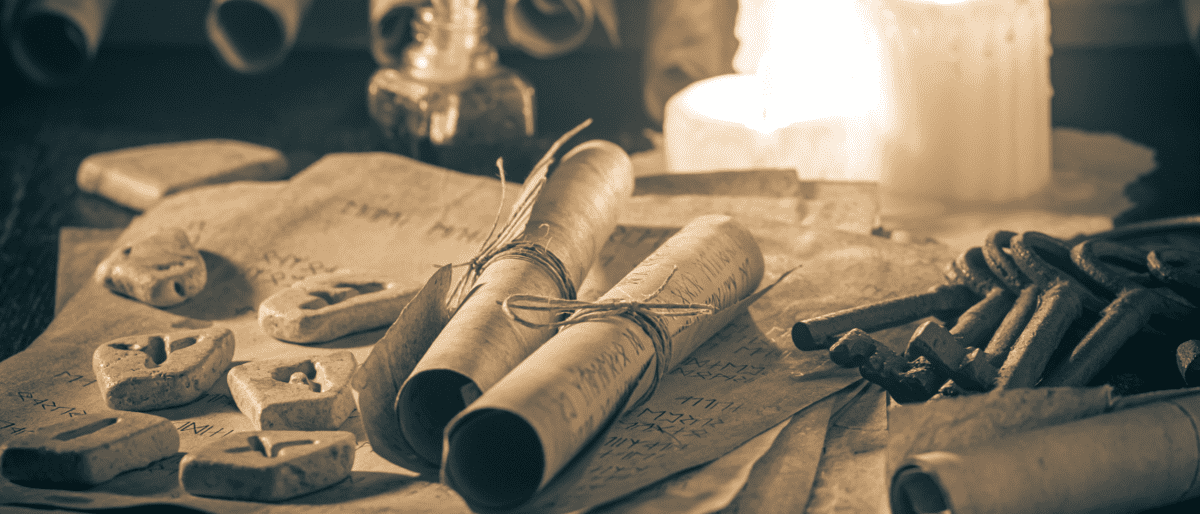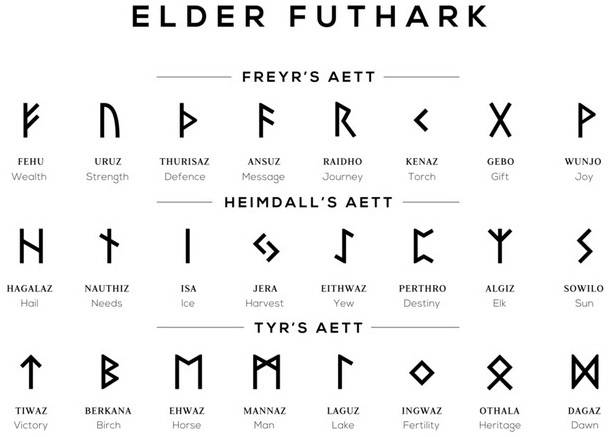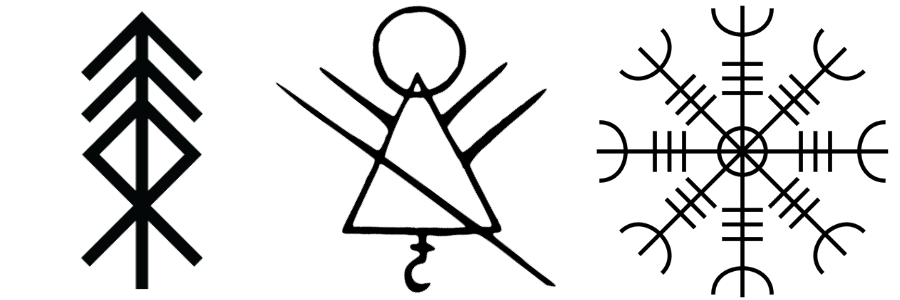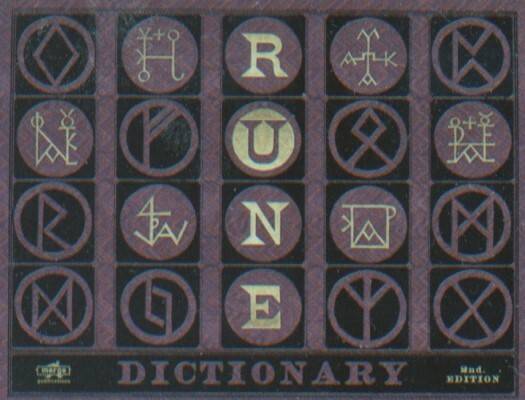Runology
 Runology has existed as a field of study for both muggle and magical kind for centuries, garnering an increase of interest around the 16th century. Despite some glaring differences between the capabilities of muggle interpreters and their wizarding counterparts, both have demonstrated that they are capable of recognizing the inherent power that numerous rune-based alphabets seem to possess.Introduction
Runology has existed as a field of study for both muggle and magical kind for centuries, garnering an increase of interest around the 16th century. Despite some glaring differences between the capabilities of muggle interpreters and their wizarding counterparts, both have demonstrated that they are capable of recognizing the inherent power that numerous rune-based alphabets seem to possess.Introduction
Runes themselves are letters, generally found within related series of alphabets collectively known as runic alphabets. However, each individual rune may have multiple connotations and meanings associated with it depending upon the culture. Though the term traditionally refers to the written form of various Germanic languages, the study of Runology amongst wizarding kind has expanded to also include ancient symbols and writings of cultures from around the world. This expanded list includes various scripts such as cuneiform, hieroglyphs, and ogham.
Even amongst muggle communities, runes have historically served as a connection to magic. Unlike wizarding kind, however, they were unable to unlock and access the full magical potential of runes. This inherent power that runes possess has been studied and utilized in a multitude of forms across both centuries and civilizations, and has served to ensure runes remain prominent in magical communities to this day.Written languages utilizing symbols as an alphabet or as logograms date back thousands of years, evolving over the centuries to expand upon their usefulness. Use of traditional Germanic runes can be dated back nearly 2000 years with the formation of the Elder Futhark. To this day, this alphabet in particular remains amongst the most recognizable and is likely to be the one most often referenced when discussing runes. Some of the written languages that came to follow directly in its steps include Angelo-Saxon futhorc and Younger Futhark, each with multiple branches of their own.Origins
It is still unclear to this day where exactly this branch of the runic alphabet originated from. Ancient writing systems from the Italian Peninsula have been found to host multiple similarities to Germanic runes in their letters and are believed to be amongst the more direct ancestors.
Written language has a vast history of evolution and intricacies, runic languages more so than most. As they were still not entirely understood, the formal study of runes first came about in the mid 16th century. Though runes were still in widespread use by muggle and wizarding kind alike, a desire to study past constructions and develop new ways with which to utilize runes struck many scholars of the time. The desire for runic innovation may not have the same popularity it once did, but many dedicated individuals remain to this day.As runes were originally intended to be carved or etched as a means to be more accessible among the common folk, rune-carving traditionally utilized everyday materials such as stone, metal and wood as a medium. Runes traditionally have angular shapes featuring no horizontal lines so as to remain more legible and prevent wood from splitting if the mark went against the grain. This is not inherently universal, however, as variant rune shapes have been discovered and developed over time. Though not as common in the past due to availability of resources amongst the masses, runic manuscripts have been uncovered in which the runes are written on parchment rather than carved into a surface.Runes
While runes do traditionally represent sound values amongst languages, they also have the capability of representing a number of concepts that typically relate to that with which they are named after. While the translated names have changed time and time again across languages, the general themes associated with the original runes tend to remain. A prime example of runes as logograms can be observed with the Elder Futhark.
While each rune may have standalone meanings and connotations, they can also be combined to form words and sentences. These capabilities open up a near limitless variety of possibilities in both their application and with trying to understand runic inscriptions. This also helps to play into the fact that, across multiple languages, the general theme attributed with their name for rune often has to do with 'secrets' or 'mystery'. A more in depth look at the Elder Futhark runes can be found in the Ancient Runes dictionary.
In magical communities, runes were able to serve as an anchor point for magic itself. In the same vein that wands help to channel the inherent magic of witches and wizards, runes were able to store and shape that magic to the specified intention. As such, runes were often used as a means of fortifying and strengthening surfaces or storing magic for extended periods of time. This could manifest in delayed reactions or maintaining effects of some spells at lessened power over a period of time.Bindrunes occur when two or more runes are joined together to create a single glyph or sigil. This can alter the meaning and intention of the runes used depending both on what they're paired with as well as the context with which they're used in. A common modern day example of a muggle based bindrune can be found within the Bluetooth logo, the combination of Younger Futhark Hagall and Berkana runes as a reference to the initials of Harold Bluetooth.Bindrunes
Another form of bindrunes can be created through the use of a stemline striking through a sequence of otherwise standalone runes, connecting them. This form is generally more common when incorporated within images or as a means with which to highlight a specific section of a runic inscription. It is often seen in use with signatures of an individual's name.
Sigils and glyphs that incorporate runes are developed and used when a more specific meaning or need is required. The art of perfecting a particular glyph can take countless hours of practice to reach a desired effect. Both patience and innovation are necessary on part of the practitioner, though unexpected combinations can occasionally still prove of use. Caution is always advised to those with magical ability experimenting with bindrunes due to the unexpected and often volatile nature of the practice.One of the primary historical uses of runes was as a means to communicate in both muggle and magical society. This was in large part due to the ease and accessibility of runic alphabets. Runes were expected to be carved or etched rather than written, which opened up the possibility for use by those of conventionally lower classes as supplies could be found anywhere rather than being limited to expensive parchments and inks.Historical Use
Runes were widely used by both muggle and magical communities within Europe during the Early Middle Ages. Ancient inscriptions can still be observed on many of the surviving magical items from the time period, but also as a means with which to record messages, stories and spell instructions for the generations yet to come. Many books from this time period had to be translated from runic script as knowledge of runes dwindled, an example of which can be found in The Tales of Beedle the Bard.
The inherent power within runes is far more subtle than with most forms of magic. On their own, a single rune may not amount to much beyond tenuous augmentation or simple messages. The real power comes forth when those blessed with the knowledge and tenacity are skilled enough to combine runes with their own magical capabilities. With the mysterious connotations runes held even amongst some muggle communities, they were often used in rituals and within sigils as a means to try and invoke these magical properties. One method of attempting to invoke the power of runes was known as Galdr, which involved singing or chanting the phonetic sound of the rune as a form of activation.
With their capacity as a means of enhancing magic, evidence of runes being used for crafting purposes can be observed across many mediums. Wands, brooms, and metalwork were often seen with runic inscriptions as a means of augmenting any particular magical attributes of the item. Though vague, records indicate that even the Elder Wand held runic inscriptions upon the handle as a means of amplification.
Though perhaps more popular amongst muggle populations, enormous runestones were often erected and etched with runes in order to record stories or stand in remembrance of powerful figures. Magical communities that utilized runestones were more often known to use them as boundary markers or as durable ward stones.
Runic divination has been prominent since around the inception of runic languages, especially amongst muggle populations. More in depth information on the functions of runic divination can be found in the Divination lore.In modern times, runes are still studied and used in common practice amongst varying aspects of wizarding kind despite their popularity having dwindled since the middle ages. While still serving as a means to translate and decode ancient texts and symbols, many of their capabilities have since expanded into a more subtle utilization amongst everyday life.Modern Use
Many witches and wizards choose to craft their own personal rune. This bindrune generally serves as a mark to include on possessions to indicate ownership, and in many cases as a signature with which to sign official documents. These runes are composed at the owner's discretion, but can often be observed as the combination of runes in a way that may spell out initials or a in a way that alludes to various ideals that the witch or wizard may hold in high regard. While many pull from the various futhark languages, there is no limit to a particular runic language these personal runes may draw from. Many choose to pull from multiple runic languages to reach a desired visual effect. Examples of personal runes were included on the 2nd edition Rune Dictionary textbook.
Many skilled craftsmen within magical society still, to this day, incorporate runes within their designs to produce more powerful and precise creations. It can take an incredible amount of skill and practice to develop runic inscriptions that reach a particular desired effect and is something runemasters can spend countless hours tweaking to perfection. While some classic sigil and rune combinations are still in use from days past, many runemasters may seek to design their own unique combinations. These unique combinations often serve as something of a personal signature amongst the crafting communities.
Outside of the world of craftsmen, runes are still commonly utilized within the Ministry of Magic for administration purposes. Official files often use runic symbols as a means of shorthand to indicate possessions or potential transgressions. Personal runes are also recorded on official records to help with tracking. With the magical capabilities of runes, personal runes also serve as a means to have on record that witch or wizard's particular magical signature infused with the physical runic signature in an effort to avoid counterfeits. Government and school officials are required to submit personal runes to have on record as a form of identification. Upon request, the Ministry of Magic may request submission of personal runes for evaluation and or in accompaniment of official documents.*Lore by Amalia Rolfö
This is the "Game Master" account. Please do not owl this account, unless specified. This account is not moderated actively and therefore, you may not receive a response.
Contact a Head of House or the Headmaster if you need anything.


